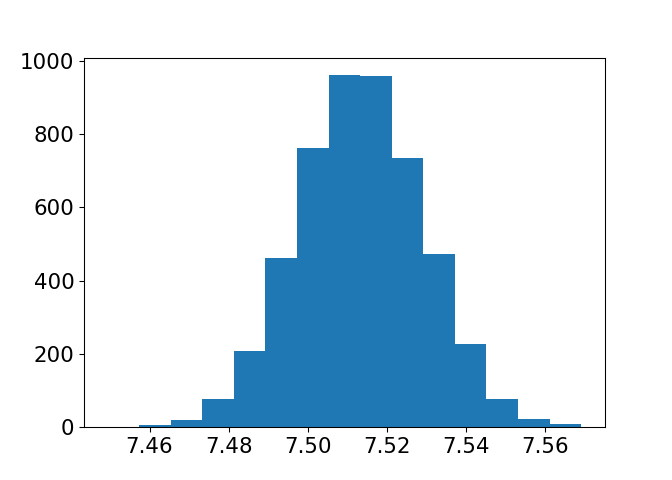Comparing sampling and bootstrap distributions
Sampling in Python

James Chapman
Curriculum Manager, DataCamp
Coffee focused subset
coffee_sample = coffee_ratings[["variety", "country_of_origin", "flavor"]]\
.reset_index().sample(n=500)
index variety country_of_origin flavor
132 132 Other Costa Rica 7.58
51 51 None United States (Hawaii) 8.17
42 42 Yellow Bourbon Brazil 7.92
569 569 Bourbon Guatemala 7.67
.. ... ... ... ...
643 643 Catuai Costa Rica 7.42
356 356 Caturra Colombia 7.58
494 494 None Indonesia 7.58
169 169 None Brazil 7.81
[500 rows x 4 columns]
The bootstrap of mean coffee flavors
import numpy as np
mean_flavors_5000 = []
for i in range(5000):
mean_flavors_5000.append(
np.mean(coffee_sample.sample(frac=1, replace=True)['flavor'])
)
bootstrap_distn = mean_flavors_5000
Mean flavor bootstrap distribution
import matplotlib.pyplot as plt
plt.hist(bootstrap_distn, bins=15)
plt.show()

Sample, bootstrap distribution, population means
Sample mean:
coffee_sample['flavor'].mean()
7.5132200000000005
Estimated population mean:
np.mean(bootstrap_distn)
7.513357731999999
True population mean:
coffee_ratings['flavor'].mean()
7.526046337817639
Interpreting the means
Bootstrap distribution mean:
- Usually close to the sample mean
- May not be a good estimate of the population mean
Bootstrapping cannot correct biases from sampling
Sample sd vs. bootstrap distribution sd
Sample standard deviation:
coffee_sample['flavor'].std()
0.3540883911928703
Estimated population standard deviation?
np.std(bootstrap_distn, ddof=1)
0.015768474367958217
Sample, bootstrap dist'n, pop'n standard deviations
Sample standard deviation:
coffee_sample['flavor'].std()
0.3540883911928703
Estimated population standard deviation:
standard_error = np.std(bootstrap_distn, ddof=1)
Standard error is the standard deviation of the statistic of interest
True standard deviation:
coffee_ratings['flavor'].std(ddof=0)
0.34125481224622645
standard_error * np.sqrt(500)
0.3525938058821761
Standard error times square root of sample size estimates the population standard deviation
Interpreting the standard errors
- Estimated standard error → standard deviation of the bootstrap distribution for a sample statistic
- $\text{Population std. dev} \approx \text{Std. Error} \times \sqrt{\text{Sample size}}$
Let's practice!
Sampling in Python

